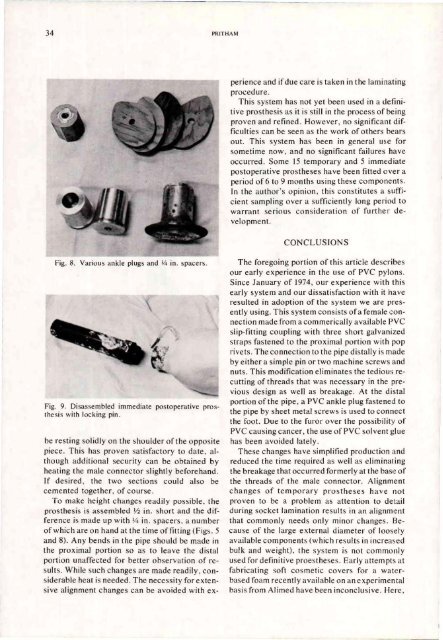Orthotics and Prosthetics
Orthotics and Prosthetics
Orthotics and Prosthetics
Create successful ePaper yourself
Turn your PDF publications into a flip-book with our unique Google optimized e-Paper software.
e resting solidly on the shoulder of the opposite<br />
piece. This has proven satisfactory to date, although<br />
additional security can be obtained by<br />
heating the male connector slightly beforeh<strong>and</strong>.<br />
If desired, the two sections could also be<br />
cemented together, of course.<br />
To make height changes readily possible, the<br />
prosthesis is assembled 1/2 in. short <strong>and</strong> the difference<br />
is made up with 1/4, in. spacers, a number<br />
of which are on h<strong>and</strong> at the time of fitting (Figs. 5<br />
<strong>and</strong> 8). Any bends in the pipe should be made in<br />
the proximal portion so as to leave the distal<br />
portion unaffected for better observation of results.<br />
While such changes are made readily, considerable<br />
heat is needed. The necessity for extensive<br />
alignment changes can be avoided with experience<br />
<strong>and</strong> if due care is taken in the laminating<br />
procedure.<br />
This system has not yet been used in a definitive<br />
prosthesis as it is still in the process of being<br />
proven <strong>and</strong> refined. However, no significant difficulties<br />
can be seen as the work of others bears<br />
out. This system has been in general use for<br />
sometime now, <strong>and</strong> no significant failures have<br />
occurred. Some 15 temporary <strong>and</strong> 5 immediate<br />
postoperative prostheses have been fitted over a<br />
period of 6 to 9 months using these components.<br />
In the author's opinion, this constitutes a sufficient<br />
sampling over a sufficiently long period to<br />
warrant serious consideration of further development.<br />
CONCLUSIONS<br />
Fig. 8. Various ankle plugs <strong>and</strong> 1/4. in. spacers.<br />
Fig. 9. Disassembled immediate postoperative prosthesis<br />
with locking pin.<br />
The foregoing portion of this article describes<br />
our early experience in the use of PVC pylons.<br />
Since January of 1974, our experience with this<br />
early system <strong>and</strong> our dissatisfaction with it have<br />
resulted in adoption of the system we are presently<br />
using. This system consists of a female connection<br />
made from a commerically available PVC<br />
slip-fitting coupling with three short galvanized<br />
straps fastened to the proximal portion with pop<br />
rivets. The connection to the pipe distally is made<br />
by either a simple pin or two machine screws <strong>and</strong><br />
nuts. This modification eliminates the tedious recutting<br />
of threads that was necessary in the previous<br />
design as well as breakage. At the distal<br />
portion of the pipe, a PVC ankle plug fastened to<br />
the pipe by sheet metal screws is used to connect<br />
the foot. Due to the furor over the possibility of<br />
PVC causing cancer, the use of PVC solvent glue<br />
has been avoided lately.<br />
These changes have simplified production <strong>and</strong><br />
reduced the time required as well as eliminating<br />
the breakage that occurred formerly at the base of<br />
the threads of the male connector. Alignment<br />
changes of temporary prostheses have not<br />
proven to be a problem as attention to detail<br />
during socket lamination results in an alignment<br />
that commonly needs only minor changes. Because<br />
of the large external diameter of loosely<br />
available components (which results in increased<br />
bulk <strong>and</strong> weight), the system is not commonly<br />
used for definitive proestheses. Early attempts at<br />
fabricating soft cosmetic covers for a waterbased<br />
foam recently available on an experimental<br />
basis from Alimed have been inconclusive. Here,
















